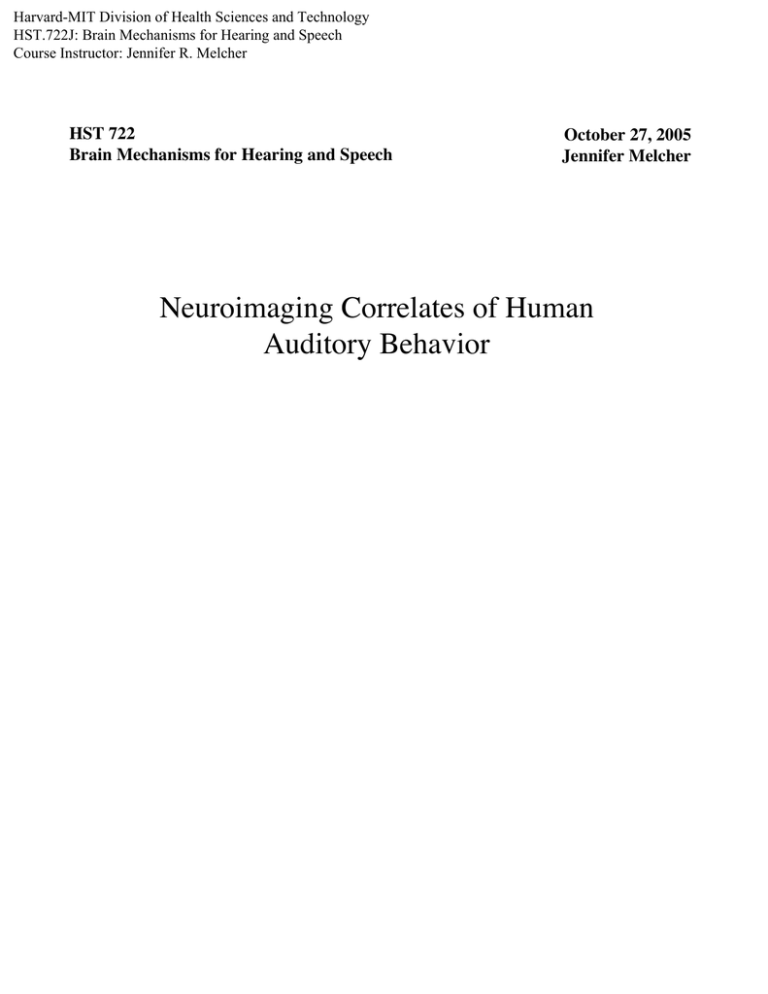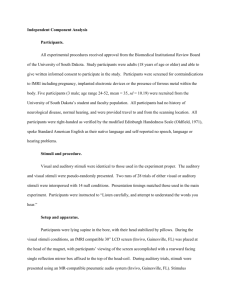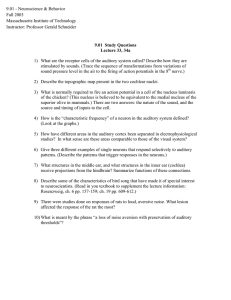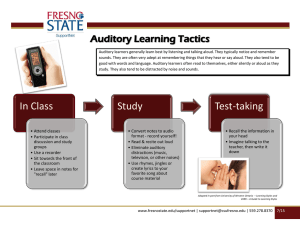Harvard-MIT Division of Health Sciences and Technology
advertisement

Harvard-MIT Division of Health Sciences and Technology
HST.722J: Brain Mechanisms for Hearing and Speech
Course Instructor: Jennifer R. Melcher
HST 722
Brain Mechanisms for Hearing and Speech
October 27, 2005
Jennifer Melcher
Neuroimaging Correlates of Human
Auditory Behavior
"The Problem"
Figure by MIT OCW.
Sound
Perception
Noninvasive
Physiologic
Measures
Neural
Activity
Figure above illustrates how auditory evoked potentials are measured. Potential shown was
evoked by a click stimulus and was recorded in a human subject. Waveform is the averaged
response to many click presentations. (AEP record from R.A. Levine)
(Courtesy of Robert Aaron Levine. Used with permission.)
Furst et al. (1985) “Click lateralization is related to the β
component of the dichotic brainstem auditory evoked
potentials of human subjects”
For binaural clicks with different ITDs and ILDs, quantified
perception
binaural difference potential
Attributes of the binaural difference are correlated with
the perception of binaural sound.
Binaural Difference Potential
CAT
HUMAN
P5
P4
Σ MON
BIN
b
BD
a
β
d
α
c
7.0 µV
CAT 24
0
4
8
0.2 µV
SU 44
12 msec
0
4
8
12 msec
Figures by MIT OCW.
Fig. 9. Binaural, sum of the monaurals, and binaural difference waveforms for both species.
The binaural (solid lines) and sum of the monaural waveforms (dotted lines) are
superimposed. The difference between these two waveforms, the binaural difference (BD)
waveform, is plotted below. The recording electrodes were vertex to nape for both species.
Stimuli were 10/sec; rarefaction clicks at 40 dB SL for the cat and 38 dB HL for the human.
(from Fullerton et al., 1987)
Binaural difference (BD) is derived from BAEPs evoked by
monaural and binaural stimuli (above). BAEP: brainstem auditory
evoked potential
The BD reflects an interaction between converging signals
from the two ears at the level of the brainstem.
Cellular Generators of the Binaural Difference Potential
b
Binaural difference
waveform
d
?
NLL/IC
Principal
cell
Spherical
cell
Lateral
lemniscus
LSO
Auditory
nerve
AVCNa
MSO
AVCNp
PVCNa
PVCNp
DCN
COCHLEAR
NUCLEUS
Trapezoid
body
Midline
LEFT SOC
RIGHT SOC
Cellular generators of the binaural difference potential in cat. Green color indicate the generators
of the first peak ('b'; white on black) and possible generators of the second peak ('d'; black on white).
The schematic of the lower auditory system (at bottom) shows the generators' relationship to other cells.
NLL, nuclei of the lateral lemniscus; IC, inferior colliculus.
Figure by MIT OCW.
Cellular generators of the binaural difference potential in cat. Diagonal line shadings
indicate the generators of the first peak (‘b’; white on black) and possible generators
of the second peak (‘d’; black on white). The schematic of the lower auditory system
(at bottom) shows the generators’ relationship to other cells. NLL, nuclei of the
lateral lemniscus; IC, inferior colliculus.
(From Melcher, 1996)
Discussion Questions:
If the generator results are combined with the findings of
Furst et al., what can be said about the neural processing
underlying sound lateralization and binaural fusion?
We generally think of the MSO as a coincidence detector.
Are Furst et al.’s binaural difference data consistent with
this idea?
Late Responses: dependence on attention and
stimulus context
Auditory Event-Related Potential
-5µv
Idealized AEP evoked by transient stimuli
( ___ ) including components that are dependent on
stimulus context and subject attention ( ….. , ----- ).
(from Hillyard and Kutas, 1983; also see Hillyard et
al., 1973; Donchin et al., 1978).
Nd
Na
N0
N1
Nb
N2
I
VI
II
P0
III
IV V
Pa
P1
P2
P3 (P300)
+5µv
10
Stimulus Onset
100
1000
Time (msec)
Figure by MIT OCW.
Nd - or “processing negativity”
- produced when the subject attends to the stimuli
- visualized by taking the difference between responses to attended and
unattended stimuli
N2 - or “N2000”, “mismatch negativity
- occurs in response to “rare” stimuli (S2 below) in oddball paradigm
- can occur even when the subject is not attending to the stimuli
- dependent on stimulus modality (e.g. auditory vs. visual)
P3 - or “P300”
- occurs in response to “rare” stimuli (S2 below) in oddball paradigm when the subject
is attending to the stimuli
- independent of stimulus modality
Figure 1-12. Schematic diagram of oddball
stimulus presentation paradigm for P300
measurement (from Squires & Hecox, 1983).
Selected measurement parameters are
indicated. Responses are averaged separately
for Stimulus Type 1 (i.e. the frequent stimulus)
and Stimulus Type 2 (i.e. the rare or oddball
stimulus). Note. From “Electrophysiological
Evaluation of Higher Level Auditory
Processing” by K.C. Squires and K.E. Hecox,
1983, Seminars in Hearing, 4 (4), p. 422.
Reprinted by permission.
(from Hall, 1992)
ODDBALL PROCEDURE
Two Stimuli, S1 & S2
Train with fixed intervals
Probabilities of S1 & S2 unequal
S1 & S2 mixed randomly
S1
S1
S1
Average 1
S1
S2
S1
Average 2
Figure by MIT OCW.
S2
N2 (N200), P3 (P300)
NS
N1
3
2
1
90
10
70
12 50 11
∆
S
N2∆
4
5
9
0
8
0
9
7
90
70
50
6
1
2
3
4
5
6
7
8
9
P2
90
70
50
P3∆
10
0
90
70
11
50
12
13
+
5µv
100 ms
Figure by MIT OCW.
Fig. 1. Mean for eight subjects of the non-signal (NS), signal (S) and difference (Δ) waveforms at each electrode site in the
auditory condition. Isopotential topographic distributions are expressed as percentages of maximum response amplitude for
the N1 and P2 components of the non-signal response (left) and the negative (N2 Δ) and positive (P3 Δ) components of the
Δ waveform (right). Supraorbital (0) and vertex (electrode 3) traces from the 3 runs are superimposed.
(From Simson et al., 1977)
NS - responses to standard stimuli (2000 Hz tone bursts)
S - responses to rare stimuli (1000 Hz tone bursts)
Δ - response to rare stimuli minus response to standard stimuli
Fig. 4. Frontal, vertex, and parietal
(across-subjects averaged) difference
waveforms obtained by subtracting the
ERP to the 1000-Hz standard stimulus
from that to the 1044-Hz deviant stimulus
at different deviant-stimulus probabilities.
The continuous line indicates the counting
condition and the broken line the ignore
condition. The amplitude of the frontocentrally distributed MMN is decreased
when the probability is increased from 2%
to 10%. When the two stimuli are
equiprobable, no MMN is seen.
From Sams et al., 1985)
s
MMN
Fz
Fz
Fz
Oz
Oz
Oz
Pz
Pz
Pz
P3
10µV
2%
10%
200 msec
MMN - mismatch negativity
Figure by MIT OCW.
50%
Kraus et al. (1996) “Auditory neurophysiologic responses
and discrimination deficits in children with learning problems”
Stimuli: Syllables, varied along two continua
Subjects: Children with and without learning problems
Measured discrimination and mismatch negativity
The children with learning problems showed
- deficits in their ability to discriminate syllables
- abnormally small mismatch negativity
Conclusion
The behavioral deficits in the children with learning
problems arose at a processing stage that precedes
conscious perception.
PET
(radioactive tracer e.g., radio-labeled H2O)
Brain
Activity
Increase
Metabolic
Response
Blood
Flow
Increase
Tracer
Increase
fMRI
(Blood Oxygenation Level-Dependent (BOLD))
Brain
Activity
Increase
Metabolic
Response
Blood
Flow
Increase
Blood
Oxygenation
Increase
Image
Signal
Increase
Human Brain
(lateral view)
Temporal Lobe
(view from above)
planum
polare
Heschl’s
gyrus
planum
temporale
Sylvian
fissure
Superior
Temporal Sulcus
anterior
lateral
Folded Cortex
(lateral view)
A
Inflated Cortex
(lateral view)
B
Computational inflation of the cortical
surface. In the inflated format, the cortex of
sulci and gyri can be viewed simultaneously.
See Fischl et al. (1999) NeuroImage 9: 195207.
C
(Courtesy of Irina Sigalovsky. Used with permission.)
Scott et al. (2000) “Identification of a pathway for intelligible
speech in the left temporal lobe”
Four stimulus conditions that included speech and several
forms of degraded speech:
- speech
- noise-vocoded speech
- rotated speech
- rotated, noise-vocoded
speech
The stimuli differed in
- intelligibility
- presence of phonetic information
- presence of pitch variations
PET activity was compared between conditions.
Conclusion
Processing unique to intelligible speech is performed
anteriorly in the left superior temporal sulcus, while lower-level
processing is performed more posteriorly in the left STS
and STG.
Discussion Questions:
Scott et al. argue that their choice of stimuli may be better
than previous ones for identifying sites of speech-specific
processing. Do you agree?
What assumptions have been made about the relationship
between brain activity and the functional specificity of
a brain region?
Beauchamp et al. (2004) “Unraveling multisensory integration:
patchy organization within human STS multisensory cortex”
Nat. Neurosci. 7: 1190-1192.
Three stimulus conditions:
- visual (videos of tools or faces)
- auditory (sounds of tools or voices)
- audio-visual (simultaneous images and sounds)
High resolution fMRI of the superior temporal sulcus, a known
region of multimodal convergence
Three types of cortical patches were identified having:
- auditory > visual response
- visual > auditory response
- auditory = visual
Conclusion
“A model… suggested by our data is that auditory and visual
inputs arrive in the STS-MS in separate patches, followed
by integration in the intervening cortex.”
Figure 2. Statistical parametric maps for contrasts of interest (group data). a, SPMs are shown as “glass brain” projections in
sagittal, coronal, and axial planes. b, SPMs have been rendered on the group mean structural MRI brain image, normalized to
the MNI standard stereotactic space (Evans et al., 1993). Tilted axial sections are shown at three levels parallel to the
superior temporal plane: 0 mm (center), +2 mm, and -2 mm (insets). The 95% probability boundaries for left and right
human PT are outlined (black) (Westbury et al., 1999). Sagittal sections of the left (x = -56 mm) and right (x = +62 mm)
cerebral hemispheres are displayed below. All voxels shown are significant at the p < 0.05 level after false discovery rate
correction for multiple comparisons; clusters less than eight voxels in size have been excluded. Broadband noise (without
pitch) compared with silence activates extensive bilateral superior temporal areas including medial Heschl’s gyrus (HG) (b,
center, yellow). In the contrasts between conditions with changing pitch and fixed pitch and between conditions with
changing spatial location and fixed location, a masking procedure has been used to identify voxels activated only by pitch
change (blue), only by spatial change (red), and by both types of change (magenta). The contrasts of interest activate distinct
anatomical regions on the superior temporal plane. Pitch change (but not spatial location change) activates lateral HG,
anterior PT, and planum polare (PP) anterior to HG, extending into superior temporal gyrus, whereas spatial change (but not
pitch change) produces more restricted bilateral activation involving posterior PT. Within PT (b, axial sections), activation
attributable to pitch change occurs anterolaterally whereas activation attributable to spatial change occurs posteromedially.
Only a small number of voxels within PT are activated both by pitch change and by spatial change.
Figures 2a, 2b from Warren, and Griffiths. “Distinct mechanisms for processing spatial sequences
and pitch sequences in the human auditory brain.” J Neurosci 23 (2003): 5799-5804.
(Copyright 2003 Society for Neuroscience. Used with permission.)
Zimmer and Macaluso (2005) “High binaural coherence
determines successful sound localization and increased
activity in posterior auditory areas”
Main Experiment:
- fMRI and behavioral measurements during sound localization
- manipulate sound location using ITD
- manipulate ability to localize by manipulating binaural coherence
- identify brain areas showing a correlation between activation and
localization performance
Control Experiments:
- separated activation specifically correlated with localization
performance from activation correlated with binaural coherence.
Conclusion
Within the superior temporal plane, only planum temporale
showed activation specifically correlated with localization
performance. It was concluded that binaural coherence cues
are used by this region to successfully localize sound.
Do sound recognition and sound
localization involve segregated
networks (i.e., "what" and
"where" pathways)? This
question was addressed by
Maeder and coworkers (2001). In
an fMRI experiment, subjects
were imaged in three conditions:
(1) during a localization task, (2)
during a recognition task, and (3)
at rest (see right).
FIG. 1 Schematic representation of the experimental paradigm, the
blocks and the temporal structure of the stimuli. L = localization task;
R = recognition task; r = rest.
Ventral cortical areas showed greater activity during the recognition task (green, below), while dorsal
areas showed greater activity during localization (red, below).
FIG.5 Active paradigm: 3-D projections of activation on smoothed normalized brain (group results). Areas more activated
in recognition than localization are shown in green, areas more activated in localization than in recognition are shown in red.
Adapted from Maeder et al. (2001) NeuroImage 14: 802-816.
Figures removed due to copyright reasons.
Please see:
Figures 1 and 5 in Maeder, et al. “Distinct pathways involved in sound recognition and localization: a
human fMRI study.” NeuroImage 14 (2001): 802-816.
Lewald et al. (2002) “Role of the posterior parietal cortex in
spatial hearing” J. Neurosci. 22: RC207.
Subjects performed a sound lateralization task before
and after cortical stimulation using transcranial magnetic
stimulation (TMS)
TMS: a noninvasive stimulation method that reversibly
alters neuronal function
Stimuli: Dichotic tones with various ITDs
Task: indicate perceived location (left or right)
Stimulation site: posterior parietal lobe
Conclusion
TMS produced a shift in sound lateralization, suggesting
a role for posterior parietal cortex in spatial hearing.
“What” and “Where” Pathways of the Visual System
Figure removed due to copyright reasons.
Please see:
Posner, M. I., and M. E. Raichle. Images of the Mind. New York, NY: Scientific American Library, 1994.
The “what” and “where” pathways in the visual system include areas specialized for processing depth perception
(symbolized by a pair of spectacles), form (an angle), color, and direction (the curve ahead sign). The result is object
recognition (the “what” pathway) or object location (the “where” pathway).
REFERENCES
Donchin, E., Ritter, W., and McCallum, W.C. (1978) Cognitive psychophysiology:
the endogenous components of the ERP. in "Event-Related Brain Potentials in Man." E.
Callaway, P. Tueting, S.H. Koslow, eds. Academic Press, New York.
Fullerton, B.C., Levine, R.A., Hosford-Dunn, H.L. and Kiang, N.Y.S. (1987)
Comparison of cat and human brain-stem auditory evoked potentials. Electroenceph. clin.
Neurophysiol. 66, 547-570.
Furst, M., Levine, R.A. and McGaffigan, P.M. (1985) Click lateralization is related
to the ! component of t he dichotic brainstem auditory evoked potentials of human
subjects. J. Acoust. Soc. Am. 78, 1644-1651.
Goldstein, M.H. Jr. and K iang, N.Y.S. (1958) Synchrony of neural activity in
electric responses evoked by transient acoustic stimuli. J. Acoust. Soc. Am. 30, 107-114.
Hall, James W. III (1992) "Handbook of Auditory Evoked Re sponses". Allyn and
Bacon, Boston.
Hillyard, S.A. and Kutas, M. (1983) Electrophysiology of cogn itive processing.
Ann. Rev. Psychol. 34: 33-61.
Hillyard, S.A., Hink, R.F., Schwent, V.L. and Picton, T.W. (1973) Electrical signs
of selective attention in the human brain. Science, 182, 177-182.
Kraus N, McGee TJ, Carrell TD, Zecker SG, Nicol TG, Koch DB Auditory
neurophysiologic responses and discrimination deficits in children with learning
problems. Science 273: 971-973 (1996).
Maeder PP, Meuli RA, Adriani M, Bellmann A, Fornari E, Thiran J-P, Pittet A,
Clarke S. Distinct pathways involved in sound recognition and localization: a human
fMRI study. NeuroImage 14:802-816 (2001)
Melcher, J.R. (1996) Cellular generators of the binaural difference potential. Hear.
Res. 95, 144 - 160.
Melcher, J.R. and Kiang, N.Y.S. (1996) Generators of the brainstem auditory
evoked potential in cat III: identified cell populations. Hear. Res. 93, 52 - 71.
Sams, M., Alho, K., Näätänen, R. (1985) The mismatch negativity and information
processing. in "Psychophysiological Approaches to Human Information Processing." F.
Scott SK, Blank SC, Rosen S, Wise RJS. Identification of a pathway for
intelligible speech in the left temporal lobe. Brain 12: 2400-2406 (2000)
Simson, R., Vaughan, H.G.Jr., and Ritter, W. (1977) The scalp topography of
potentials in auditory and visual discrimination tasks. Electroenceph. clin. Neurophysiol.
42: 528-535.
Wang, B. and Kiang, N.Y.S. (1978) Synthesized compound action potentials
(CAP's) of the auditory nerve. J. Acoust. Soc. Am. 63: S77.
Wang, B. (1979) The relation between the compound action potential and unit
discharges of the auditory nerve. Ph.D. Thesis, Massachusetts Institute of Technology.
fMRI: Mitigation of Scanner Acoustic Noise
Clustered Volume Acquisition: A method for removing the impact of scanner acoustic
noise on auditory fMRI activation
Figure removed due to copyright reasons.
Please see:
Edmister, et al. Human Brain Mapping 7 (1999): 89-97.
Selected References
Slide 7: �
Fullerton, B. C., R. A. Levine, H. L. Hosford-Dunn, and N. Y. Kiang. "Comparison of�
cat and human brain-stem auditory evoked potentials." Electroencephalogr Clin�
Neurophysiol 66, no. 6 (Jun 1987): 547-70.�
Slide 8: �
Melcher, J. R. "Cellular generators of the binaural difference potential." Hear Res
95 (1996): 144-160.�
Slide 10 (Top figure): �
Hillyard, S. A. and M. Kutas. "Electrophysiology of cognitive processing." Ann Rev�
Psychol 34 (1983): 33-61.�
Slide 10 (Bottom figure): �
Hall, James W. "Handbook of Auditory Evoked Re sponses." Allyn and Bacon.
Boston, I, II, 1992.�
Slide 11 (Top figure): �
Simson, R., H. G. Vaughan, Jr., and W. Ritter. "The scalp topography of potentials in �
auditory and visual discrimination tasks." Electroenceph clin Neurophysiol 42 (1977):
528-535.�
Slide 11 (Bottom figure):�
Sams, M., K. Alho, and R. Näätänen. "The mismatch negativity and information �
processing." Psychophysiological Approaches to Human Information Processing. 1985. �






